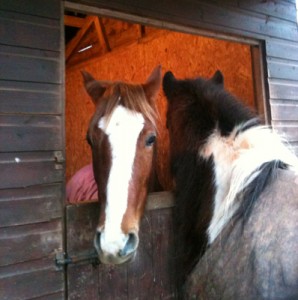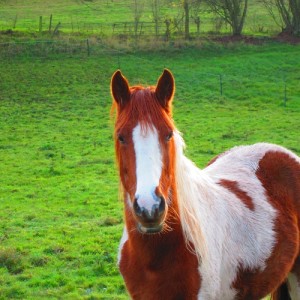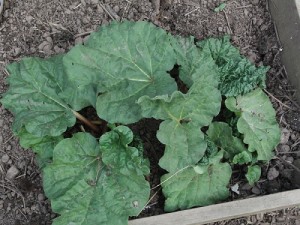Equine biology- a simple, helpful explanation about the basics of a cell

I am about to explain the very basics of a complicated and specialized science. I will only explain the things which are easy to mentally digest, and will start with the basic structure of a cell, then I will move on to a quick briefing on DNA.
The basic units of measurement for a cell are micrometers = one thousandth of a millemetre and nanometer (nm) = one thousandth of a micrometer.
The cell membrane is semi-permiable, so called because it allows certain substances to pass through, but not others. It is made up of a specific group of lipids (fats) called phospholipids. They have a rounded ‘head’ and a wavy ‘tail’. The tail is hydrophobic (repels and ‘hates’ water) and the head is hydrophillic (attracts and ‘loves’ water). The membrane is made up of two layers of phospholipids, and each layer meets the other tail to tail. Fat soluable molecules pass through the phospholipids.This is because the phospholipids are not attached and can move in a ‘wave’ in response to external ‘stimulus’ of essential molecules, therefore opening a gap. The molecules then have to wait in the middle of the membrane for another gap to open because only one layer opens at a time. Water soluble ones pass through special proteins known as pores. The membrane is studded with proteins, some only in one layer, carrying a polysacharide as a marker to avoid white blood cells accidentally destroying the cell, mistaking it for an invader, others spanning the entire membrane, and helping water soluble substances to pass into the cell (pores).
Within the membrane is a jelly like liqid known as the cytoplasm. It contains water, nutrients waste and dissolved substances. Suspended within the cyoplasm is the are the various organelles of the cell.
The nucleus is the control centre, it is the largest organnelle in the cell, and contains DNA. I will explain more about DNA later on. Within the nucleus is the nucleolus, which manufactures ribosomes.
The ribosomes (20nm) are the location of protein synthesis, the place where a chain of amino acids is made into a protein such as an enzyme (a globular protein that reacts with its substrate (the molecule it acts on) to create a product). Some ribosomes float freely in the cytoplasm while others are found on the endoplasmic reticulum (ER). Smooth ER has no ribosomes attached, while rough ER has ribosomes. Free ribosomes make products for the cell, while those on the rough ER make products for exportation from the cell. A structure known as the golgi body or dictyosome packages finished proteins into transport vesicles, which are very important, especially for enzymes which might start to digest the cell otherwise.
Mitochondria are the sites of respiration, the place where reactions occur. Oxygen and glucose are necesary for this to happen. The reactions that occur provide the cell with an instant energy source, mostly in the form of ATP (adenosine triphosphate) which is made up of a sugar (ribose) a base, adenosine, and three phosphate molecules. This is broken down to ADP (adenosine diphosphate) + one inorganic phosphate. This provides the cell with energy, and the unnecessary by products are sent out of the cell (heat, water, CO2). A metabolically active cell such as a smooth muscle cell has lots of mitochondria. This system can only provide energy for up to ten seconds, even with CP as a backup molecule. After all the immediate ATP has gone, glucose oxidation occurs to create more. One minute or more of exersise, and lipids are oxidised and used as an energy source insead.
Perioxisomes (one micrometre) are small structures that breakdown hydrogen peroxide, a highly toxic by- product, into harmless oxygen and water.
That was a short description of a cell, now i will focus on genes. These are what determines our appearance, our horses appearance, and the appearance of mans best friend (dog) and all the other living creatures. Below are some key words.
Genotype= the arrangement of genes
phenotype= the way genes express themselves (appearance)
loci (si. locus)=a ”point” on DNA (at each ‘base’) where the gene is found
allelle=a variation of a gene (brown eyes and wall eyes are from the ‘eye colour’ gene but cause different effects and so are different allelles.
Dominant= a gene that creates an effect, even if only one strand of DNA contains that particular gene
Recessive= a gene that requires two doses on one locus (one dose on each strand) to produce an effect.
A dexyribonucleic acid molecule consists of a sugar (deoxyribose) a phosphate group (phosphorus molecule) and two organic bases which combine to form a ‘rung’ of the ‘ladder’ of DNA. DNA is twisted into a double helix and ‘pushed together’ into tightly coiled chromosomes.
Each base has a particular shape and its pair has a complementary shape, meaning that no other base can combine with it. In DNA, Adenine always pairs with Thymine and Cytosine always pairs with Guanine but with RNA T is absent and in its place is Uracil. A and G are purines, which are larger than their partners, while C and T are smaller and known as pyrimidines.
DNA never leaves the cell. If a copy is needed for the ribosomes to assemble a protein, then ribonucleic acid transports the information gets to its target structure, therefore it is a mobile copy of a gene.
To create a protein, a copy of DNA is made onto the messengerRNA and taken to a ribosome. Part of the DNA uncoils and the DNA sequence is copied onto mRNA and taken to the ribosome. TransferRNA is made upof a single strand of nucleic acid, looped back on itself to create a clover leaf shape that collects amino acids and brings them to the ribosome which then makes an amino acid chain in order of instruction which, once complete becomes a protein.
Horses have 64 chromosomes. 62 of these are responsible for various parts of the horse, such as colour, etc. but the last two are sex chromosomes. These are known as X and Y. Female chroosomes are XX and male chromosomes are XY. The females ovum is always X. For this reason it is the males sperm that determines the of the foal. Y is dominant, and so if a Y chromosome comes from the male the result is a colt. Despite Y being dominant, there is an equal chance of a filly as there is a colt.
Cells split through mitosis and meiosis. The former is for growth and the latter is for reproduction. The former produces two identical cells with the full number of chromosomes (diploid), while the latter produces four cells with half the number of chromosomes (haploid). When the ovum and the sperm fuse, the full number chromosomes is restored. If this did not occur, the number of chromosomes would double with every generation.
That wasjust a quick explanation about The equine cell, and DNA, if it is a subject that takes your interest, more information can be found in an equine genetics book or online.
Recommended reads;
Equine science by Sarah Pilliner and Zoe Davies.
Horses







Recent Comments